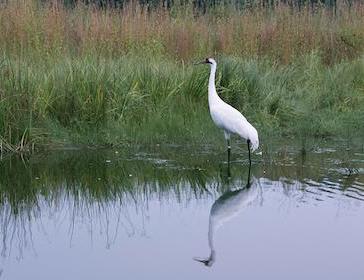 Texas officials scored a victory Monday in a court case with potentially far-reaching implications for policies governing the allocation of water resources under increasing, competitive demands as the state’s population grows and scientists project hotter, drier conditions in a changing climate.
Texas officials scored a victory Monday in a court case with potentially far-reaching implications for policies governing the allocation of water resources under increasing, competitive demands as the state’s population grows and scientists project hotter, drier conditions in a changing climate.
A federal appeals court reversed a 2013 ruling by a federal district judge aimed at aiding the severely endangered whooping crane species. The judge had temporarily halted new water-use permits in the San Antonio and Guadalupe river systems, which serve urban populations, agriculture and industry.
Members of a migrating population of whooping cranes, one of the nation’s most famous endangered species, rely each winter on Texas coastal habitat in the Aransas National Wildlife Refuge that is nourished by freshwater flows in those rivers.
A non-profit organization called The Aransas Project had won the order to stop new water permits by arguing in a lawsuit that the water-allocation decisions of the Texas Commission on Environmental Quality had violated the federal Endangered Species Act by causing the deaths of 23 cranes in the winter of 2008-09.
The appeals court’s three-judge panel declared that the plaintiffs had not established that the TCEQ, in issuing water permits, had “foreseeably and proximately” caused the birds’ deaths.
The panel said there was “a long chain of causation” between the state-authorized water withdrawals from the two rivers and the subsequent decline in freshwater inflows and the reduction in cranes’ food sources in their marshy winter habitat that The Aransas Project had contended – and the trial judge agreed – was the cause of the 23 deaths.
“Every link of this chain depends on modeling and estimation,” the appeals judges said. “At best, the [district] court found but for causation. Proximate cause, however, requires the causal factors and the result to be reasonably foreseeable.”
The whooping cranes’ deaths, the appeals panel concluded, were “too remote” from the water withdrawals permitted by the TCEQ for a finding that state officials violated the Endangered Species Act.
The TCEQ issued statements by a current and former commissioner celebrating the agency’s courthouse win.
TCEQ Chairman Bryan W. Shaw: “TCEQ remains committed to protecting the needs of the environment as part of its holistic evaluation of requests to appropriate state water. The initial decision of the district court would have had drastic implications for water availability throughout the state.”
Carlos Rubinstein, chairman of the Texas Water Development Board, who was a TCEQ commissioner when the lawsuit was filed: “This decision is an important victory for Texas and how we manage water resources in our state.”
Jim Blackburn, a Houston attorney and Rice University professor who represented The Aransas Project, provided a statement to Texas Climate News suggesting that the legal fight is not over:
This case was very narrow and generally supported our position on a number of key issues. The 5th Circuit [Court of Appeals] was concerned about foreseeability and indirect liability of the State but certainly laid out a blueprint of what to do the next time. They did not overturn findings of fact, including the fact that the whooping cranes were killed by water withdrawals. The real question is who to sue and on what grounds. In the long term, this case opens up many options. So, it hurts in the short term but may be just fine for the cranes in the long term.
The lawsuit over water permits represents one more chapter in a much broader, decades-old history of contention in Texas over how much water should be left in the state’s river systems to nourish ecosystems in coastal bays and estuaries and the wildlife species that depend on them.
In a 2012 article for TCN about The Aransas Project’s lawsuit, Houston journalist and journalism educator Michael Berryhill wrote:
The whooping crane suit could serve as a signal to Texas water planners to include the Texas bays, including their multimillion-dollar fishing and tourism industries, as part of the [state’s water] planning, along with cities, industry and agriculture. Or it could be a signal that in the coming water wars – which increasing droughts and other climate-change impacts that scientists have projected for Texas could undoubtedly aggravate – both planners and conservationists need to lawyer up.
– Bill Dawson
Image credit: Hagerty Ryan, U.S. Fish and Wildlife Service
